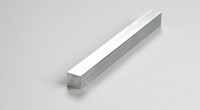| Items |

6061-T6S-375
Aluminum Squares - Series 6061-T6
|

6061-T6S-500
Aluminum Squares - Series 6061-T6
|

6061-T6S-625
Aluminum Squares - Series 6061-T6
|

6061-T6S-750
Aluminum Squares - Series 6061-T6
|

6061-T6S-1000
Aluminum Squares - Series 6061-T6
|
|
Material
|
N/A
Aluminum
|
|
Shapeform
|
N/A
Squares
|
|
Series
|
N/A
6061-T6
|
|
Grade
|
N/A
6061
|
|
Temper
|
N/A
T6
|
|
Size
|
N/A
3/8 inches
|
N/A
1/2 inches
|
N/A
5/8 inches
|
N/A
3/4 inches
|
N/A
1 inches
|
|
Size
|
N/A
0.375 inches9.525 mm
|
N/A
0.5 inches12.7 mm
|
N/A
0.625 inches15.875 mm
|
N/A
0.75 inches19.05 mm
|
N/A
1 inches25.4 mm
|
|
Estimated Weight
|
N/A
0.1654 lbs/ft0.2461423256 kg/m
|
N/A
0.294 lbs/ft0.437520216 kg/m
|
N/A
0.4594 lbs/ft0.6836625416 kg/m
|
N/A
0.6615 lbs/ft0.984420486 kg/m
|
N/A
1.1760 lbs/ft1.750080864 kg/m
|
|
Estimated Weight per 12' Bar
|
N/A
1.985 lbs0.900380914 kg
|
N/A
3.528 lbs1.6002739872 kg
|
N/A
5.513 lbs2.5006549012 kg
|
N/A
7.938 lbs3.6006164712 kg
|
N/A
14.112 lbs6.4010959488 kg
|
|
ASTM Specification
|
N/A
ASTM B221
|
|
Stock Length
|
N/A
12 ft
|
|
Ultimate Strength
|
N/A
45 ksi
|
|
Yield Strength
|
N/A
40 ksi
|
|
Elongation percent in 2 inches
|
N/A
12
|
|
Hardness Brinnel Number
|
N/A
95
|
|
Ultimate Shearing Strength
|
N/A
30 ksi
|
|
Fatigue Endurance Limit1
|
N/A
14 ksi
|
|
Modulus of Elasticity2
|
N/A
10.0 x 104 ksi
|
|
Resistance to Corrosion - General3
|
N/A
B
|
|
Stress Corrosion Cracking4
|
N/A
A
|
|
Workability (Cold)5
|
N/A
C
|
|
Mechinability
|
N/A
C
|
|
Brazeability6
|
N/A
A
|
|
Gas Weldability7
|
N/A
A
|
|
Arc Weldability8
|
N/A
A
|
|
Resistance Spot and Seam Weldability9
|
N/A
A
|
|
Applications
|
N/A
Anodized auto and appliance trim
|
|
Density
|
N/A
0.098 lbs/in³
|
|
Specific Gravity
|
N/A
2.78
|


